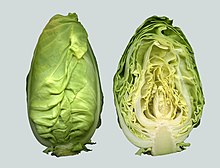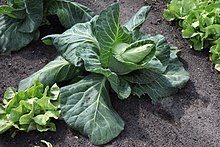cabbage
Cabbage or cabbage is with the white cabbage ( Brassica oleracea var. Capitata f. Alba related) species of vegetables cabbage with delicate, yellowish to bluish green, large leaves and tapered growth. Its taste is more subtle and finer than that of white cabbage. As the earliest variety of cabbage, it will be on the market in spring; harvested later, it is also called summer cabbage .
Red pointed cabbage is processed into kysané zelí in northern Bohemia . The cabbage ferments simply by adding salt, resulting in red sauerkraut.
The cultivation of pointed cabbage is declining, as normal white cabbage is easier to machine due to its round heads and has higher yields.
Pointed cabbage can be used like savoy cabbage or white cabbage. Because of its delicate leaf structure, however, it should cook for a shorter time. It is also suitable for salads and raw vegetables .
Filderkraut
Filderkraut is named after the Fildern , a fertile plain with loess soils south of Stuttgart . It is a variant of pointed cabbage with tightly wound heads made of fine leaves, which is mainly processed into sauerkraut . Filderkraut / Filderspitzkraut has been registered with the EU as a Protected Geographical Indication (PGI) since October 24, 2012 . Many producers in the Fildern cultivate their own varieties and produce their own seeds. Only a few manufacturers sell sauerkraut made from pointed cabbage.
The Filder cabbage Brassica oleracea var. Capitata fo. alba subfo. conica is included in the ark of taste at Slow Food .
Web links
Individual evidence
- ↑ kheuberger: Slow Food Germany eV ~ Filder cabbage. In: www.slowfood.de. Retrieved October 24, 2016 .
- ↑ Implementing Regulation (EU) No. 975/2012 of the Commission of October 19, 2012 for the entry of a name in the list of protected designations of origin and protected geographical indications (Filderkraut / Filderspitzkraut (PGI)). In: Official Journal of the EU. October 24, 2012.




